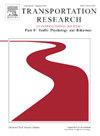有条件自动驾驶环境下自由选择非驾驶相关活动对驾驶员疲劳和行为的影响
IF 3.5
2区 工程技术
Q1 PSYCHOLOGY, APPLIED
Transportation Research Part F-Traffic Psychology and Behaviour
Pub Date : 2025-06-05
DOI:10.1016/j.trf.2025.05.033
引用次数: 0
摘要
在条件自动驾驶(CAD, SAE Level 3)中,驾驶员疲劳是一个关键的安全风险。研究人员已经研究了解决这一问题的几种对策。CAD期间的非驾驶相关活动(NDRAs)在预防驾驶员疲劳方面显示出相当大的希望,应该进行更详细的评估。本研究的目的是探讨自由选择NDRAs作为对抗驾驶疲劳的潜在对策。为此,78名参与者参加了2x2混合设计的驾驶模拟器实验。参与者在CAD之前和之后手动驾驶,比较驾驶员疲劳对驾驶性能的影响。在CAD期间,参与者被随机分配到两种情况中的一种:有或没有NDRA。第一种情况的参与者在CAD期间的卡罗林斯卡嗜睡量表(KSS)达到7分后被允许进行NDRAs。对驾驶员疲劳、接管性能和驾驶性能进行了评估。结果显示,在CAD过程中,有NDRA组的驾驶员疲劳程度明显低于没有NDRA组。然而,NDRA对第二次手动驾驶的驾驶性能(即车头距、碰撞时间、横向位置标准差)没有显著影响。驾驶员疲劳导致第二次驾驶时驾驶性能明显下降。结果表明,NDRA仅在CAD期间影响驾驶员疲劳,而在CAD之后对手动驾驶性能没有影响。本文章由计算机程序翻译,如有差异,请以英文原文为准。
Impact of free-choice non-driving related activities on driver fatigue and performance in the context of conditional automated driving
A critical safety risk during conditional automated driving (CAD, SAE Level 3) is driver fatigue. Researchers have investigated several countermeasures to address this issue. Non-driving related activities (NDRAs) during CAD have shown considerable promise in preventing driver fatigue and should be evaluated in more detail. The aim of this study was to investigate free-choice NDRAs as a potential countermeasure against driver fatigue. For this purpose, 78 participants took part in a driving simulator experiment with a 2x2 mixed design. The participants drove manually before and after CAD to compare the impact of driver fatigue on driving performance. During CAD, the participants were randomly assigned to one of two conditions: with vs. without an NDRA. The participants of the first condition were allowed to engage in NDRAs after reaching a 7 on the Karolinska Sleepiness Scale (KSS) during CAD. Driver fatigue, takeover performance, and driving performance were assessed. The results revealed that driver fatigue was significantly lower during CAD in the group with an NDRA than without. However, the NDRA had no significant effect on driving performance (i.e., distance headway, time-to-collision, standard deviation of lateral position) in the second manual drive. Driver fatigue resulted in significantly worse driving performance in the second drive. The results showed that an NDRA only impacted driver fatigue during CAD, not manual driving performance afterwards.
求助全文
通过发布文献求助,成功后即可免费获取论文全文。
去求助
来源期刊
CiteScore
7.60
自引率
14.60%
发文量
239
审稿时长
71 days
期刊介绍:
Transportation Research Part F: Traffic Psychology and Behaviour focuses on the behavioural and psychological aspects of traffic and transport. The aim of the journal is to enhance theory development, improve the quality of empirical studies and to stimulate the application of research findings in practice. TRF provides a focus and a means of communication for the considerable amount of research activities that are now being carried out in this field. The journal provides a forum for transportation researchers, psychologists, ergonomists, engineers and policy-makers with an interest in traffic and transport psychology.

 求助内容:
求助内容: 应助结果提醒方式:
应助结果提醒方式:


